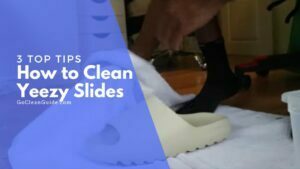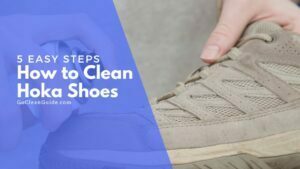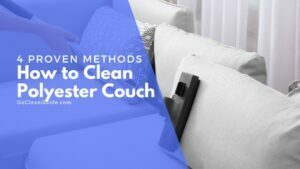Maintaining the pristine condition of your car’s interior, especially the perforated leather seats directly impacts your driving experience. But how exactly do you clean those delicate perforations without causing damage? Welcome to our comprehensive guide on how to clean perforated leather seats.
This article is designed to help car enthusiasts, like you, keep those upscale leather seats looking as luxurious as the day they were first installed. By applying these helpful techniques, you’ll not only extend the life of your leather seats but also ensure a comfortable and stylish ride. Buckle up as we dive into the world of effective and safe leather seat cleaning!
How to Clean Perforated Leather Seats Quick Guide
Knowing how to clean perforated leather seats properly is essential, after all standard leather seats are completely covered, making them less breathable; in contrast, perforated leather seats feature tiny holes that enhance breathability, ensuring a more comfortable ride for passengers.
In this section, we share with you four best practices when cleaning perforated leather.
- Vacuum the seats, paying attention to perforated areas
- Utilize a high-quality leather cleaner along with a leather brush
- Use a clean microfiber towel to remove any excess
- Use Leather Conditioner
How to Clean Perforated Leather Seats: Best Practices
After a brief summary of how to clean perforated leather, it’s time to understand each step in more detail.
Vacuum the seats, paying attention to perforated areas
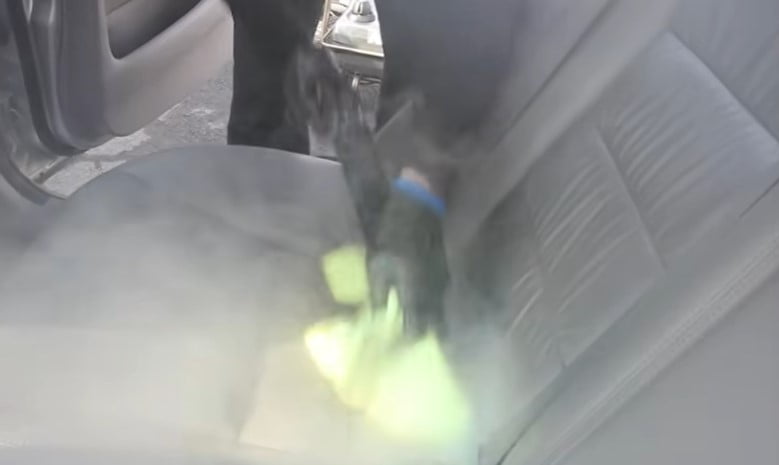
Begin by meticulously vacuuming the leather seats, paying extra attention to the minuscule holes unique to perforated leather. These tiny perforations are prone to trapping dirt, making them more challenging to clean compared to standard leather seats. Dedicate ample time to this step, ensuring that every single hole is thoroughly cleaned.
Furthermore, it is vital to handle the vacuuming process with utmost care to prevent any damage to the leather. Unlike regular leather seats, perforated seats require a more delicate approach. Utilize a gentle vacuum nozzle and proceed cautiously, ensuring that no scratches or harm comes to the seats.
Utilize a high-quality leather cleaner along with a leather brush

Once you’ve finished vacuuming, proceed to clean the leather using a high-quality leather cleaner and a specialized brush designed for leather cleaning.
Instead of directly spraying the cleaner onto the seats, apply it to the brush. Then, gently work the cleaner into the seats, paying close attention to removing any dirt from the crevices.
Be mindful not to use excessive amounts of cleaning solution. It’s better to use a conservative amount and repeat the process if needed, rather than risking over-saturation.
Remember to utilize a dedicated leather cleaning brush, as they are designed to be both gentle and effective in cleaning car leather seats. Avoid any potential damage by using the right tools for the task at hand.
Use a clean microfiber towel to remove any excess
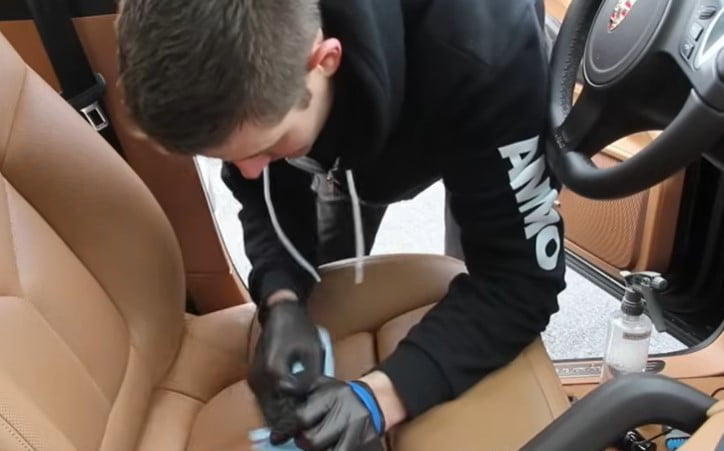
After brushing, use a clean microfiber towel to wipe down the seats and remove any leftover cleaner. If you notice product buildup in the perforations, you may need to vacuum a second time to fully clear them. For heavily soiled seats, lightly dampen the microfiber towel with the additional cleaner to ensure a thorough clean.
Use Leather Conditioner
To ensure the longevity of your perforated leather seats and prevent cracking, it’s important to condition them regularly. Invest in a high-quality leather conditioner and follow these steps: Pour a small amount onto a clean microfiber towel and gently apply it to the seats.
This extra step of conditioning will provide superior protection and prolong the life of your leather. Don’t forget, that a few minutes of additional effort during your seat cleaning routine can go a long way in preserving the beauty and durability of your seats.
Common Questions About How to Clean Perforated Leather Seats
After learning the best practices on how to clean perforated leather seats, let’s take a few minutes to go through some of the most common questions.
What tools are best for how to clean perforated leather seats?
Air compressor: If dirt becomes trapped in the small holes, you can connect an air blower gun to your compressor and use compressed air to dislodge it. This method is highly effective for removing solid particles such as rocks, food, or dust. After using the air compressor, a quick wipe-down or vacuuming may be necessary to clean up any dislodged dirt.
Toothpicks: To tackle stubborn dirt in perforated seats, specialized tools like toothpicks, interdental brushes, or gum stimulators can work wonders. These tools are particularly handy for cleaning those hard-to-reach individual holes that often remain dirty even after a general cleaning.
Steam Cleaner: A steam cleaner is an invaluable asset for auto detailing, particularly when dealing with stubborn spills like milk or chocolate that have seeped into perforated leather seats. By harnessing the power of steam, it effectively softens and breaks down these stains, facilitating their removal using a variety of tools such as brushes, vacuums, or microfiber towels. However, it’s important to note that while a steam cleaner is highly effective, it works best when used in conjunction with other tools.
Use a Fine Vacuum Nozzle: To enhance the cleaning of perforated leather seats, it is crucial to use a vacuum with a thin nozzle. This slender attachment amplifies suction power and allows for focused cleaning of small areas, effectively removing trapped dirt. While a high-powered vacuum is not necessary, the thin nozzle is the key component. For optimal results, it is recommended to use the thin nozzle in conjunction with other cleaning methods such as air compressors or steam cleaners.
How can you effectively clean perforated leather seats after a spill?
If you encounter a spill on your perforated leather seats, here are some helpful tips to address the issue effectively:
- Begin by promptly soaking up as much of the spill as possible using towels or absorbent materials.
- Gently apply a mild soap solution with warm water to clean the leather seats.
- Rinse the area with plain water to remove any residue.
- Thoroughly blot the seats dry to prevent moisture retention.
- As a preventive measure, apply a small amount of baking soda to the affected area using a cloth.
- Allow the baking soda to sit for approximately 15 minutes, then sweep it off.
- Finally, proceed with the regular cleaning and conditioning of your seats.
By incorporating baking soda into the process, you can effectively clean and neutralize potential odors caused by spills. This method can also be applied to address odors resulting from vomit, milk, and chocolate stains.
How to get rid of unpleasant odor from perforated leather seats?
If you come across any unpleasant odors while cleaning, try a quick solution of equal parts water and vinegar before using your leather cleanser. After letting it sit on the leather for 5 minutes, simply wipe it off with clean water. Be cautious not to leave it on for too long as the vinegar scent may linger.
What mistakes should you avoid when cleaning perforated leather seats?
- Excessive Use of Cleaner: Applying an excessive amount of leather cleaner can result in product buildup within the perforations, making it challenging to remove later on.
- Spraying Directly: Spraying cleaner directly onto the seats can cause the liquid to become trapped in the small holes, potentially leading to issues with mold or mildew.
- Improper Tool Usage: Using brushes that are too harsh can cause scratches or damage to the leather. Always opt for tools specifically designed for cleaning leather.
- Neglecting Vacuuming: Failing to thoroughly vacuum before cleaning can push dirt further into the perforations.
- Ignoring Follow-Up Steps: Neglecting to wipe down or re-vacuum after cleaning can leave behind residue or trapped dirt, diminishing the overall effectiveness of the cleaning process.
- Relying on a Single Method: Depending solely on one cleaning method, such as using a steam cleaner, will not completely remove dirt from the perforations. It is best to combine multiple methods for a thorough cleaning.
- Rushing the Process: Cleaning perforated leather seats requires time and attention to detail. Rushing through the steps can result in subpar results and potential damage.
- Not Testing Products: Failure to test cleaning products on a small, inconspicuous area before full application can lead to discoloration or damage to the leather.
Video How to Clean Perforated Leather – SUPER EASY!
Want to know how to clean perforated leather seats look like? Watch the following video for a demonstration of a simple and efficient method of cleaning perforated leather.
Final Thoughts
In conclusion, cleaning perforated leather seats can appear to be a daunting task, but armed with the right tools and knowledge, it can be straightforward and effective. From using an air compressor and specialized tools like toothpicks to utilizing a steam cleaner and a fine vacuum nozzle, each method plays a crucial role in maintaining the cleanliness and longevity of your perforated leather seats.
Quick and efficient spill management, odor elimination, and an understanding of common cleaning mistakes further empower you to keep your perforated leather seats in top-notch condition. Remember that combining multiple cleaning methods and giving due time and attention to each step is key to achieving the best results. So, don’t shy away from dedicating the necessary time and effort – your leather seats will thank you for it!



